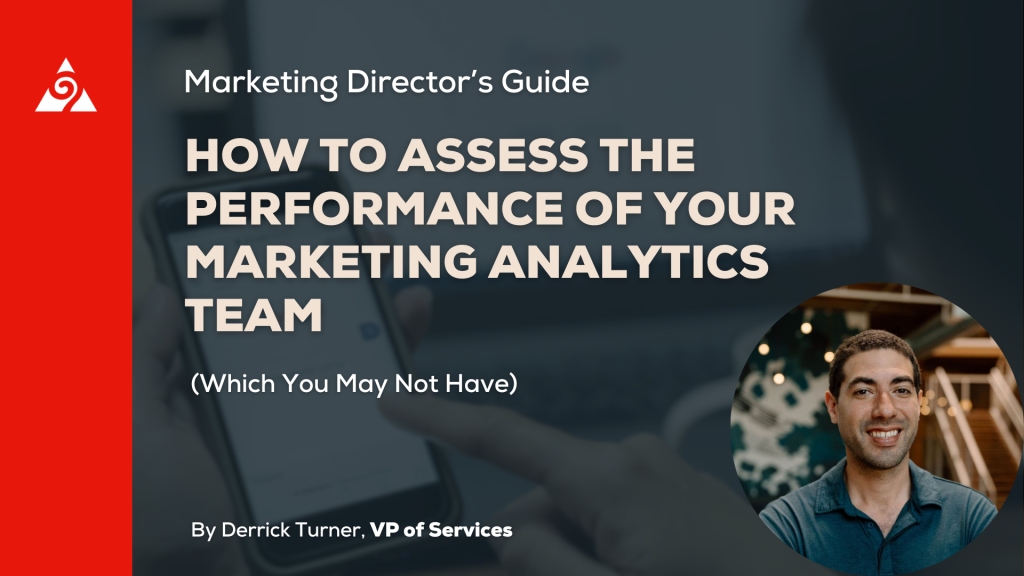You know that marketing analytics is pivotal in driving business growth and understanding consumer behavior. If you have the right setup, you can leverage it into actionable digital marketing tactics. However, for marketing leaders with limited resources like yourself, evaluating the performance of a marketing analytics team—which might not even exist yet—can be a daunting task.
I aim to provide you with practical evaluation criteria and examples to help you determine whether you are close to having the right situation for effective marketing analytics.
Evaluation Criteria
- Understanding of Business Objectives: Your analytics team, whether a single individual or a group, must deeply understand your business goals. Are they aligned with your marketing objectives? Do they know what success looks like for your business? Leadership in your organization may be focused on specific outcomes, like first-time customers or increasing same-store growth. If your analytics set-up can’t shape stories around specific objectives, it will be hard to evaluate current performance & justify your work, and even more difficult to identify trends that can inform future strategy.
- Example 1: If your goal is to increase online sales by 20% in the next quarter from first-time customers, your team should focus on first-time customer acquisition instead of just reporting on total sales.
- Example 2: You’re hosting advertisements on your website for your vendors. Can you measure customer engagement in a way that clearly explains to your vendors the value of the ads? Do you have easy-to-access reports that can be shared with vendors routinely?
- Data Collection and Management: Evaluate how effectively your team collects and manages data. Are they using the right tools? Is the data accurate and relevant? Do you trust it? Depending on the tactics you’re looking at, there may be different “sources of truth.” An example could be leads measured in your CRM compared to leads totals recorded in Ga4. Do the measurements align? Do they always move in the same direction? When things change, are you able to understand why? The data you measure should have a purpose, and you must trust what it’s telling you if you’re bothering to collect it in the first place. It is common for marketing leaders to inherit an analytics structure that isn’t very well understood and seems daunting to change. If you are in a situation where you don’t have much use for the current analytics provided to you, and it seems overwhelming to work with, it’s probably time for a change.
- Example 1: For a small online retailer, using Google Analytics to track website traffic and conversions might be sufficient. But if data is often missing or misinterpreted, it’s a sign of a gap in skills or tools.
- Example 2: You’re leveraging GA4 but want to discuss historical results. Has your team proactively retained the historical data, or is it lost when GA4’s data retention limit exceeds those dates?
- Analytical Skills and Tools: Assess the team’s ability to analyze data. Can they identify trends, patterns, and insights that are actionable? Or do they report on metrics no one else seems to care about?If you find yourself waiting for reports and receiving numbers you find difficult to understand or use, that is a symptom of an opportunity to improve your analytics situation. If you have communicated the metrics you’re interested in and do not see clear reporting that tells a story every week, you could likely benefit from an external perspective about making your reporting work harder.
- Example 1: In a campaign to increase email subscriptions, the team should be able to segment the audience and identify which segment is most responsive to your campaigns instead of just saying, “It went up, or it went down.”
- Example 2: Your CPCs have increased 30% year over year. Is this due to bidding tactics, increased competition, or changes in the advertising inventory associated with the campaign? Are there measures that the team can take to change these trends? Given business results, does it matter?
- Reporting and Communication: It’s crucial that your team communicates its findings effectively. Are their reports understandable and actionable? Do they provide insights that can drive decision-making?Your reporting should address the good, bad, and ugly. Identifying what isn’t working is crucial, and deciding what to cut or double down on is one of the most impactful conversations in digital marketing. Reporting shouldn’t solely focus on justifying what has been done but critically evaluate whether there is an opportunity to improve the current state.
- Example 1: A good report might show that most of your website traffic comes from organic search, suggesting that you should invest more in SEO rather than paid advertising.
- Example 2: A tactic you have leveraged for a long time is no longer working as effectively as it used to. Why has performance changed? Is it worth spending money on this tactic, or are there other tactics that have more opportunity?
- Adaptability and Learning: The digital landscape is constantly evolving. Does your team stay updated with the latest trends and tools? Are they learning and adapting? New tools are available every year that have the potential to improve your team’s efficacy. Is your organization spending some time each year to understand what’s changed and whether it should be adopted? Are you progressing each year in terms of doing more with less time? This should be an evergreen conversation each year, as finding wins in this area allows your team to use their time more efficiently and take actions that drive bigger business impact.
- Example 1: If a new analytics question becomes available, your team should be curious and eager to see how it can be integrated into reporting and elevated to the stakeholders who need it.
- Example 2: New functionality was introduced in Ga4 to help automatically identify trends or metrics changes that need to be elevated. Has action been taken to identify how those could help you and your team?
- Impact on Business Results: Ultimately, the team’s performance should be judged by the impact on your business. Are their efforts leading to increased sales, better customer engagement, or improved brand awareness? The ideal scenario for any analytics team is that it can tie digital results to actual sales. Any marketing change can be analyzed in terms of its impact on the bottom line. The full-funnel view is critical. Changes in strategy may change top-line results such as lead volume, but if your strategy was to target higher-value accounts, simply comparing the cost per lead of such a strategy may lead to the wrong conclusions. Often, the sales conversion rates will change with strategy, so if you are driving fewer leads but closing business more often, you won’t be able to judge it accurately without the ability to see the full funnel result in your reporting.
- Example: You are testing whether it’s more beneficial to focus on first-time customer acquisition, knowing the return associated with digital marketing advertising will decrease as returning customers won’t be targeted. Is the return from marketing higher when you analyze the long-tail value of those new customers coming back to order again? Without the ability to measure the full expected impact of the strategy, it may be hard to justify the results unless the full context can be measured.
What does this look like in practice?
The Good: An Ideal Scenario
In a good situation, your marketing analytics partner operates like a well-oiled machine, whether in-house or an agency partner. They have a robust understanding of your business objectives and align their efforts accordingly. For instance, if your goal is to enhance customer engagement, they consistently analyze customer feedback and engagement metrics, providing actionable insights to improve your strategies.
Your team is adept at data collection and management, using advanced tools like CRM systems and Google Analytics proficiently. They’re not just collecting data but are making sense of it. Their reports are clear, concise, and directly correlate with your marketing goals. For example, they can pinpoint your business’s most effective marketing channels and why. You should also have access to this data without long lag times. Some teams still rely on reports to be built monthly versus having created systems that allow you real-time access to answer questions when you have them.
Moreover, this team adapts quickly to new technologies and trends. They might experiment with predictive analytics to forecast future trends, keeping you ahead of the competition. The impact of such a team is evident in the ROI of your marketing campaigns, with clear metrics demonstrating success, such as a significant increase in lead generation or customer retention rates. In today’s context, a lot of the learning curve is ensuring they are up-to-date and understand metric definitions in GA4, which varies from older products like Universal Analytics.
The Bad: A Less Ideal Scenario
Conversely, your marketing analytics team or agency partner may lack alignment with your business goals in a bad situation. Their reports might be filled with data but lack actionable insights. For example, they might report on increased website traffic without delving into whether this traffic leads to conversions or aligns with your target audience.
In this scenario, the team might be..
- Using outdated tools
- Not fully utilizing the capabilities of current tools,
- Inaccurately collecting data
- Communicating with metrics that don’t directly tie to business outcomes
- Confusing non-technical team members preventing them from acting upon their findings
- Resisting new methods or technologies putting your business at a competitive disadvantage
- Driving little to no impact on ROI, customer engagement, or brand awareness.
This can look like working with an inherited measurement system that is no longer completely understood. There is fear of changing because the implications of changes aren’t fully understood, leaving the organization with a system that no one wants to/or can work with.
Another warning signal is that they aren’t thinking ahead. An example of this is a team that collects data in GA4 but doesn’t understand that they need to store that data somewhere to ensure your organization has long-term access to it after the data retention period is over.
What should you do?
In conclusion, assessing the performance of your marketing analytics team requires a comprehensive look at their understanding of business objectives, data management, analytical skills, communication, adaptability, and impact on business results. Even with limited resources, by focusing on these key areas, you can gauge how close you are to having an effective marketing analytics team and identify areas for improvement. Remember, the goal is to make data-driven decisions that align with your business objectives and drive growth.




